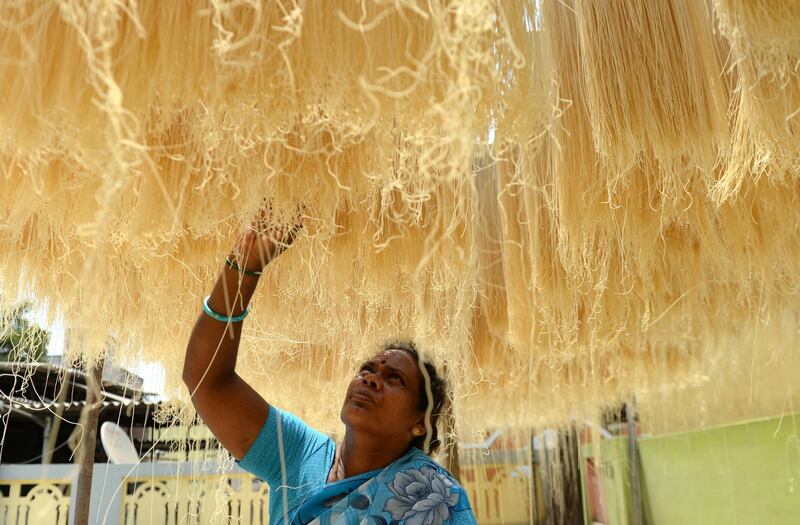Entrepreneur Revathi Roy was so concerned about the lack of work opportunities for women from poor backgrounds in India that she decided to take action.
Three years ago she set up a parcel delivery service in Mumbai, which only employs women from low-income families, training them to drive its vans and motorcycles before they become delivery agents. The company, called HeyDeeDee, has since branched out to six other Indian cities including Bangalore and Kolkatta. It now has about 400 female delivery agents.
“Women's participation in the workforce in India is very dismal,” says Ms Roy.
Her initiative aims to address a broader issue across the country, with many women either not working, leaving the workforce or not being paid on par with men – resulting in wealth inequality.
Although India is the world's fastest growing major economy, data shows that wealth is not necessarily reaching a large number of females in the country. India's gross domestic product expanded by 7.3 per cent in the financial year to the end of March 2019, according to the World Bank's forecast. But women only own between 20 and 30 per cent of India's $6 trillion (Dh22.03tn) household wealth compared to the global figure of 40 per cent, according to investment bank Credit Suisse.
Experts say that deep-rooted cultural factors are a major part of the problem.
“India is largely a patriarchal society,” says Shachi Irde, the chief consulting partner and adviser to Catalyst, a global nonprofit organisation that works with companies to help attract women into the workforce. “Gender stereotypes and socio-cultural factors are some of the barriers.”
Research by Catalyst finds that women receive 62 per cent less income than men in India. The country has been ranked 108th in the World Economic Forum's (WEF) gender gap index.
It's a critical issue at a time when India is in the midst of a general election, as Indian prime minister Narendra Modi seeks re-election, with voting held in phases until May 19 before results are announced on May 23. The number of female voters is expected to rise to outnumber male voters in the polls, according to psephologists. Official statistics show the turnout of women was only 47 per cent of the female electorate in 1962, but it rose to 66 per cent in the last national election in 2014.
“Gender parity is fundamental to whether and how economies and societies thrive,” according to the World Economic Forum.
Despite India's rapid economic growth over the past decade, figures find that women are actually leaving the workforce. Women's participation in the labour force declined to 24 per cent in the financial year to March 2016 compared to 36 per cent a decade earlier, according to India's Economic Survey, a government report. Female participation in the labour force in the UK and US is about 46 per cent, while in China it is approaching 44 per cent, according to the World Bank.
Females failing to earn as much as their male counterparts plays a significant role in this trend.
"The gender-based pay gap is huge,” says Megha Malik, the co-founder of DesignerPeople, a branding agency in India. “This is the main reason why many bright minds have to give up their jobs as the responsibilities in their personal lives increases.”
The gender pay gap becomes more pronounced as women's careers progress in India, according to analysts.
“High-potential women and men start out on an equal footing when it comes to job level and pay,” says Ms Irde. “Unfortunately, despite this extremely promising start, a gender gap emerges over time. Women earn less, receive fewer developmental opportunities that lead to advancement, and bear more responsibility at home compared to men.”
There is still a widespread perception in India that men are the breadwinners while women have to be responsible for the household, which can make it difficult for females to be fairly paid at work.
With a population of 1.3 billion, India has the potential to add $770 billion to its gross domestic product by 2025 if it boosts the number of women working in the country, representing an 18 per cent increase on what it would be otherwise, according to a report by global consultancy McKinsey. Unpaid work carried out by women in the home, including looking after children and the household chores, is worth 3.1 per cent of the country's GDP, according to Oxfam International.
"A pay gap versus gender inequality is a global trend and there is a much wider gap observed in India," says Geeta Ramakrishnan, an ontological coach and author of Game of Change, which focuses on ways to help women achieve success. "The perception that women seek a job to augment family income against personal fulfilment, is one of the main reasons for this disparity."
Srividya Kannan, the founder and director of Bangalore consultancy Avaali Solutions, says “there is still bias towards men because of a perception that they may be more productive and willing to travel as required by the job”.
Shruti Arora, the president of the Confederation of Education Excellence, a New Delhi think-tank, says that women are often not encouraged to focus on education and employment, particularly in small towns.
“Often their potential is not fulfilled because they have to get the permission from their family, and if the family doesn't support this, the female doesn't work,” says Ms Arora.
Concerns about the safety of women in India is another issue that prevents women entering the workforce, she adds.
However, steps have now been taken by the Indian government to boost female participation in the workforce and give them a level playing field with their male counterparts. India's maternity benefit law was amended in 2017, for example, to increase the length of paid maternity leave to 26 weeks from 12 weeks.
It also became law for offices with 50 employees or more to provide a crèche for working mothers – although many companies have not complied with this regulation yet. Under the Companies Act 2013, which came into force in October 2014, it is also mandatory for firms to have at least one female director on their boards, although a number of companies have met this requirement by simply appointing a family member to the position.
“There are a number of governmental and non-governmental initiatives that are working on the ground,” says Ms Irde. “They help women get access to funds, for example there are now micro-financing organisations providing loans for women to start up small businesses. There are number of subsidies offered by government owned banks for women entrepreneurs wanting to start or expand business in different sectors.”
She says many corporations have also introduced their own initiatives to encourage women to work. Hindustan Unilever and Coca-Cola, for example, have helped females in rural India start small businesses, while other companies have introduced initiatives such as flexible working hours.
“We need more organisations to focus on engaging and including women not only in the corporate sector but also encouraging them to take up paid work in every sector,” says Ms Irde.
Ms Roy, meanwhile, agrees that more needs to be done to improve the situation for women's employment and earning potential in India. However, she is confident the situation will improve as women start to assert themselves more, including exercising their democratic rights and turning out to vote in the general election.








